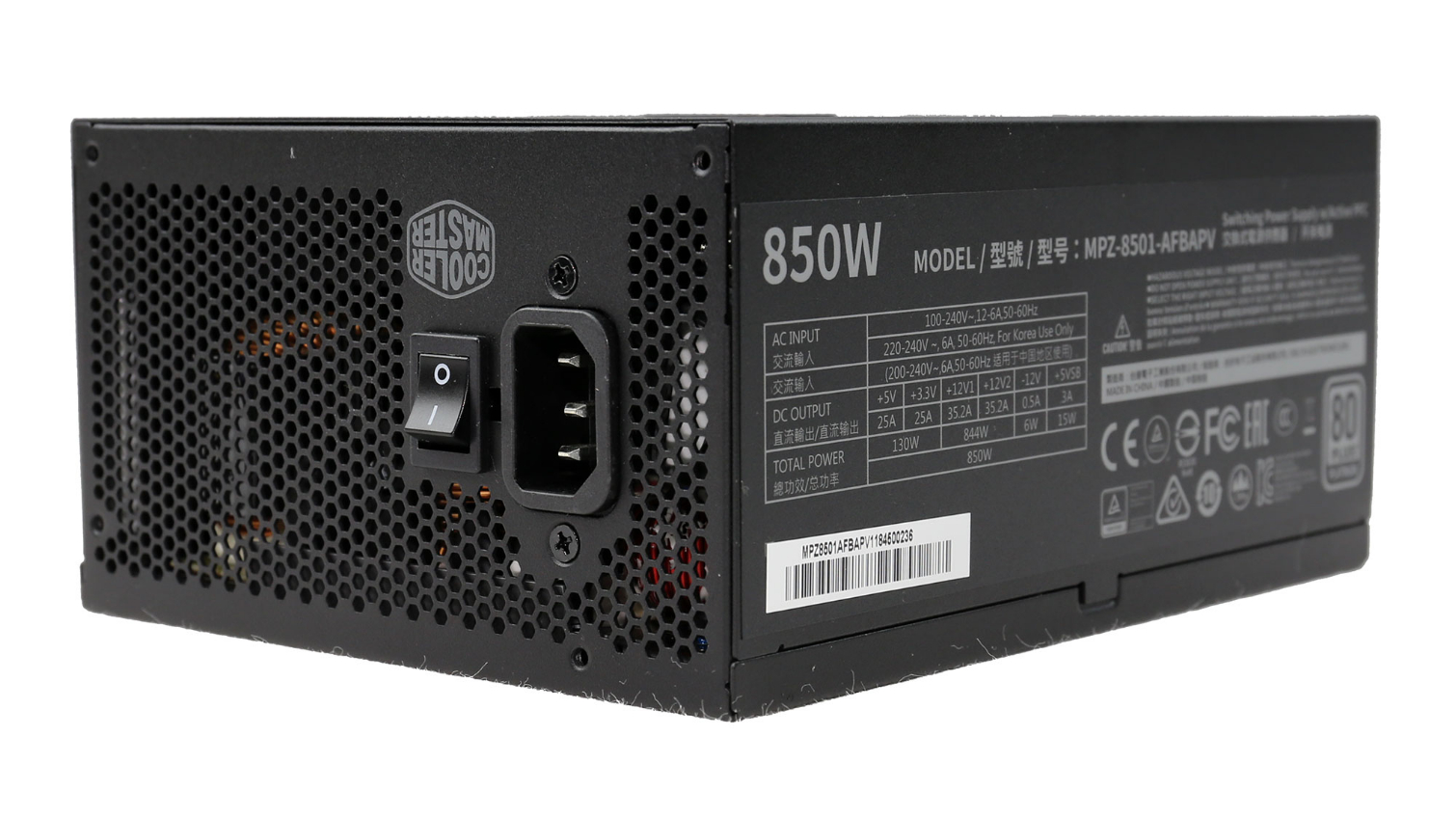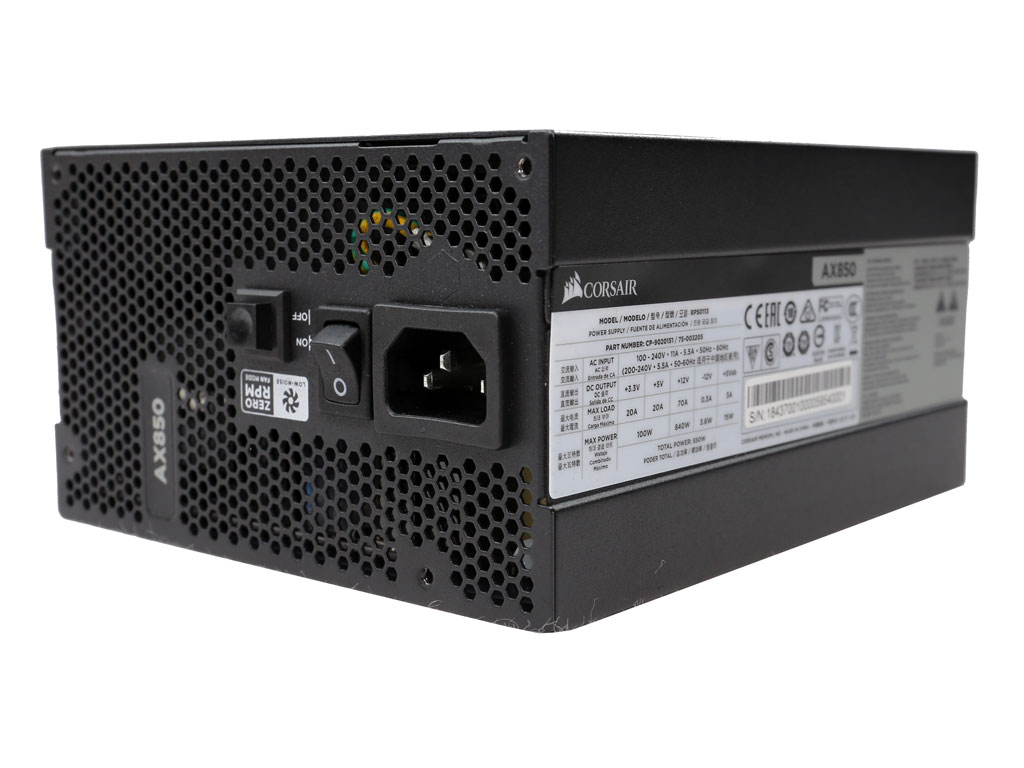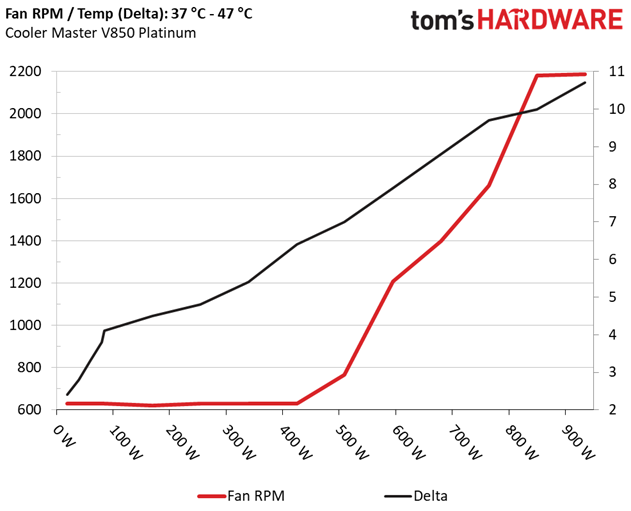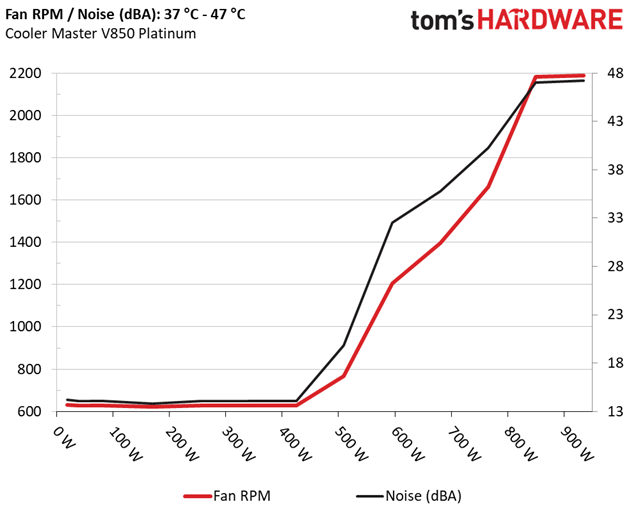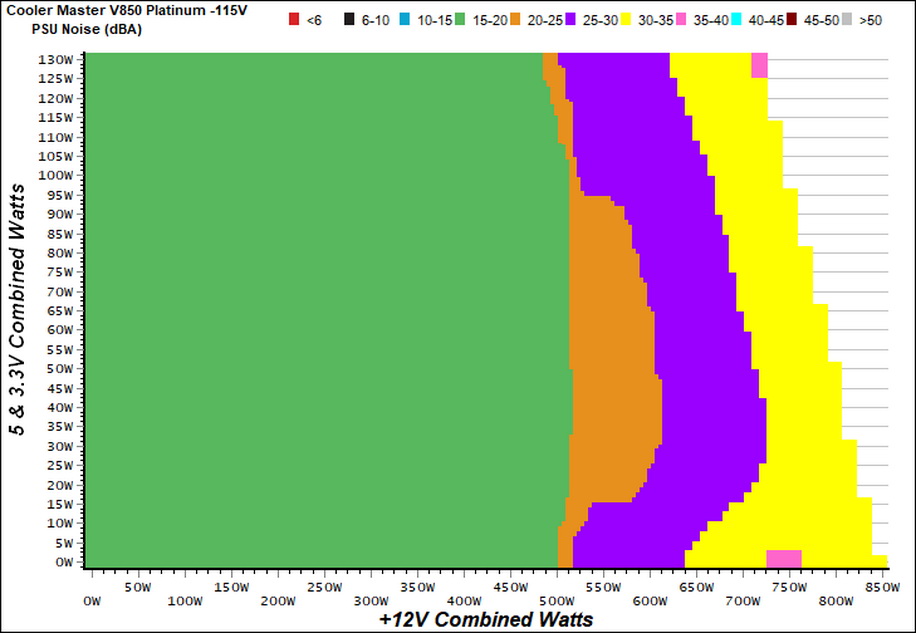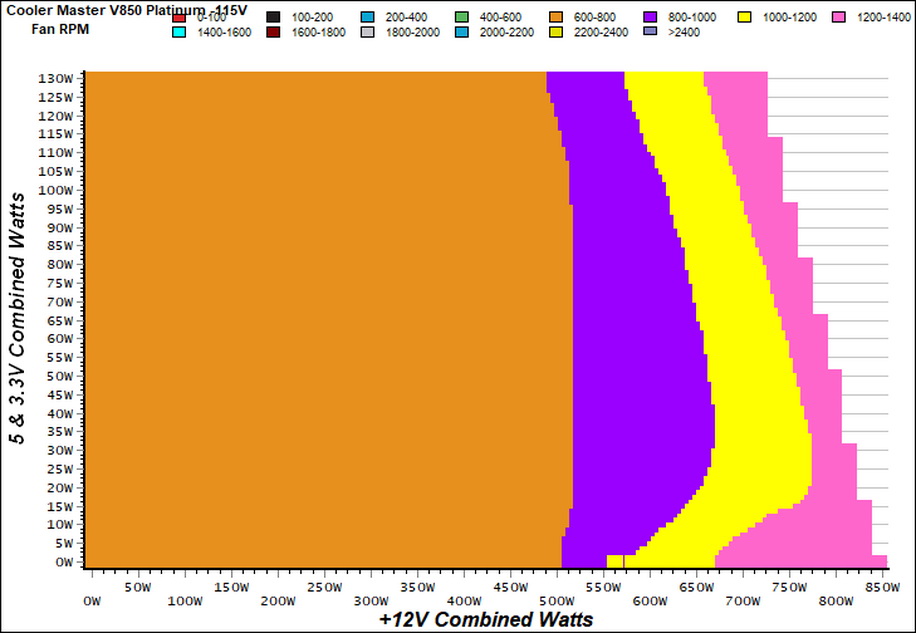Cooler Master V850 Platinum Power Supply Review
Why you can trust Tom's Hardware
Load Regulation, Hold-Up Time, Inrush Current, Efficiency and Noise
To learn more about our PSU tests and methodology, please check out How We Test Power Supply Units.
Primary Rails And 5VSB Load Regulation
The following charts show the main rails' voltage values recorded between a range of 40W up to the PSU's maximum specified load, along with the deviation (in percent). Tight regulation is an important consideration every time we review a power supply, because it facilitates constant voltage levels despite varying loads. Tight load regulation also, among other factors, improves the system’s stability, especially under overclocked conditions and, at the same time, it applies less stress to the DC-DC converters that many system components utilize.
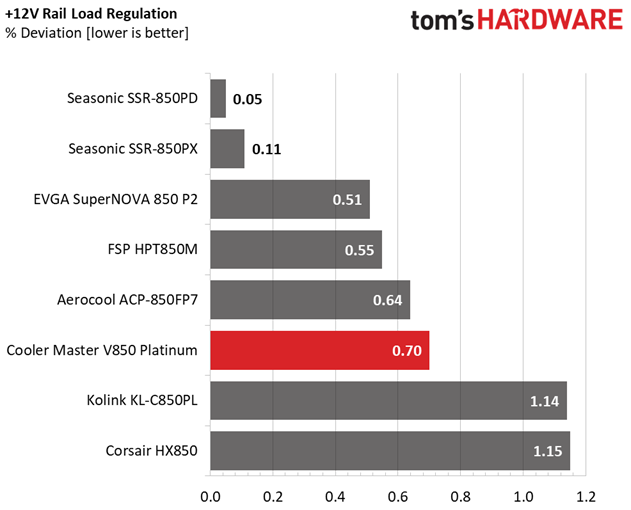

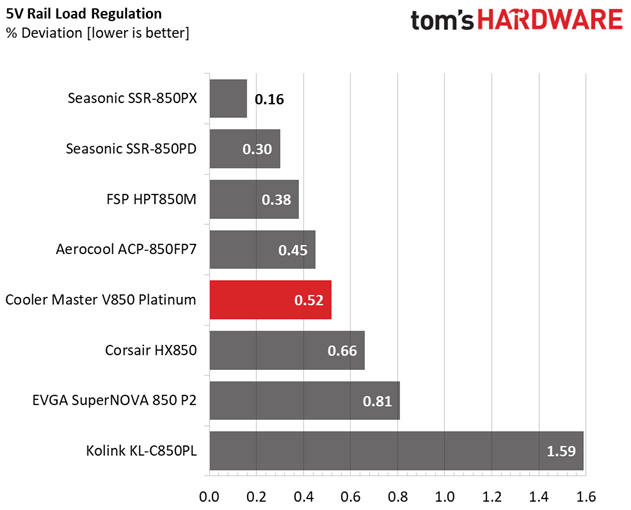

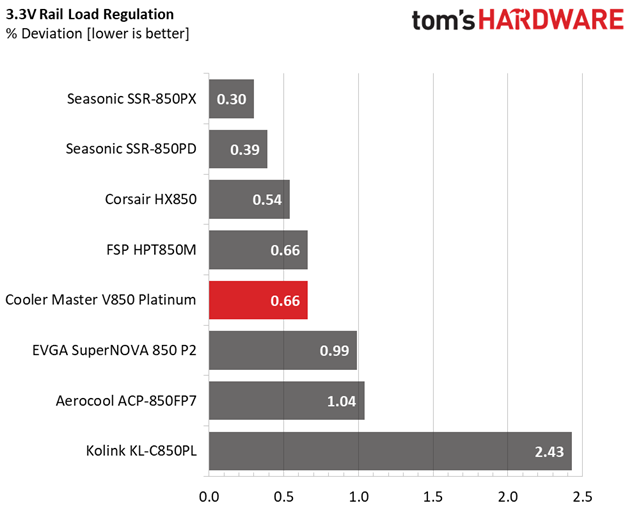


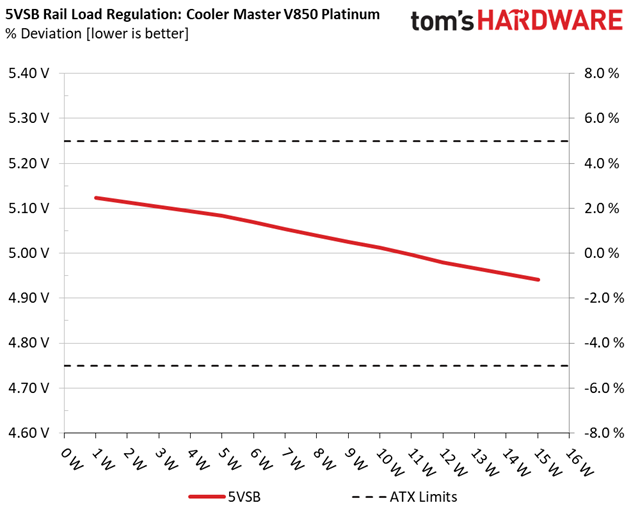
The load regulation is tight enough on all rails but the 5VSB one, where the deviation is close to 3.6%.
Hold-Up Time
Put simply, hold-up time is the amount of time that the system can continue to run without shutting down or rebooting during a power interruption.

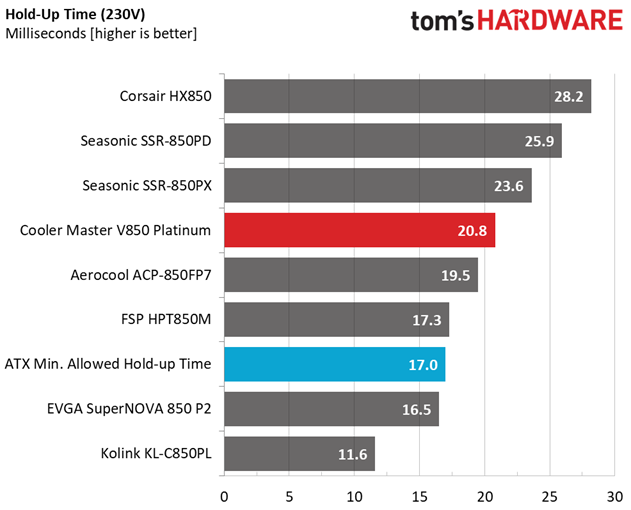

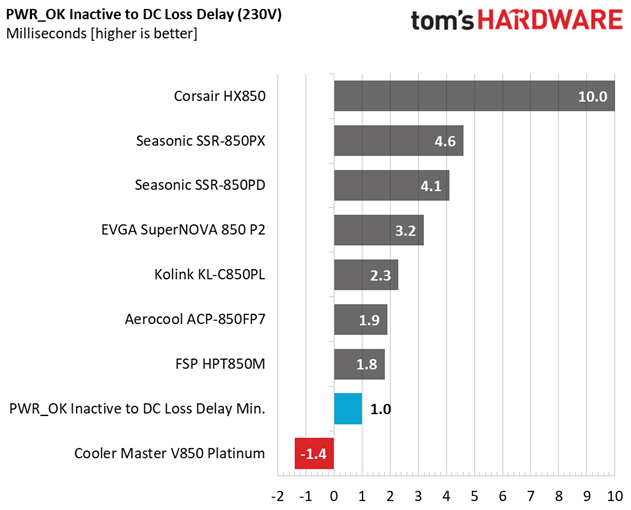
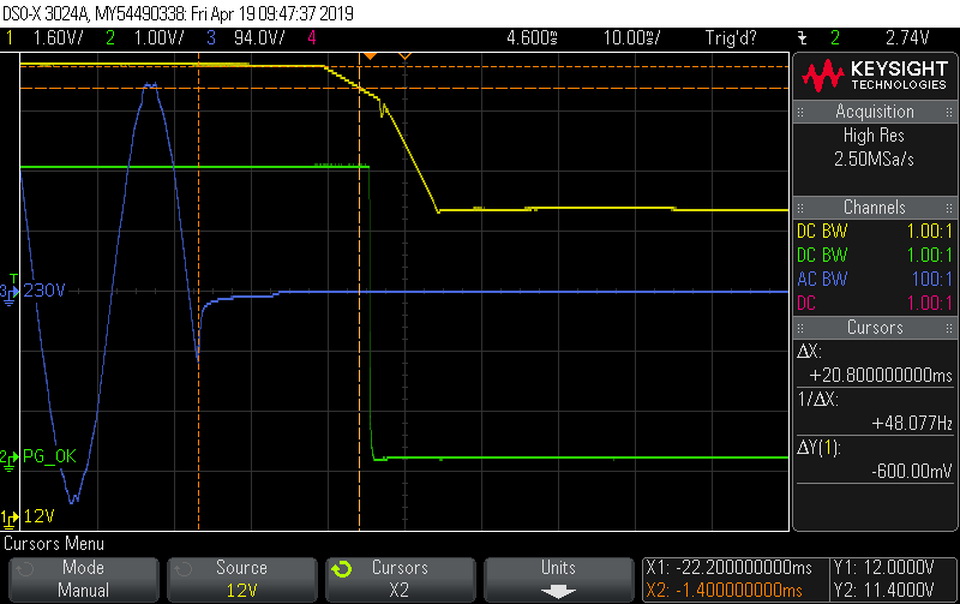

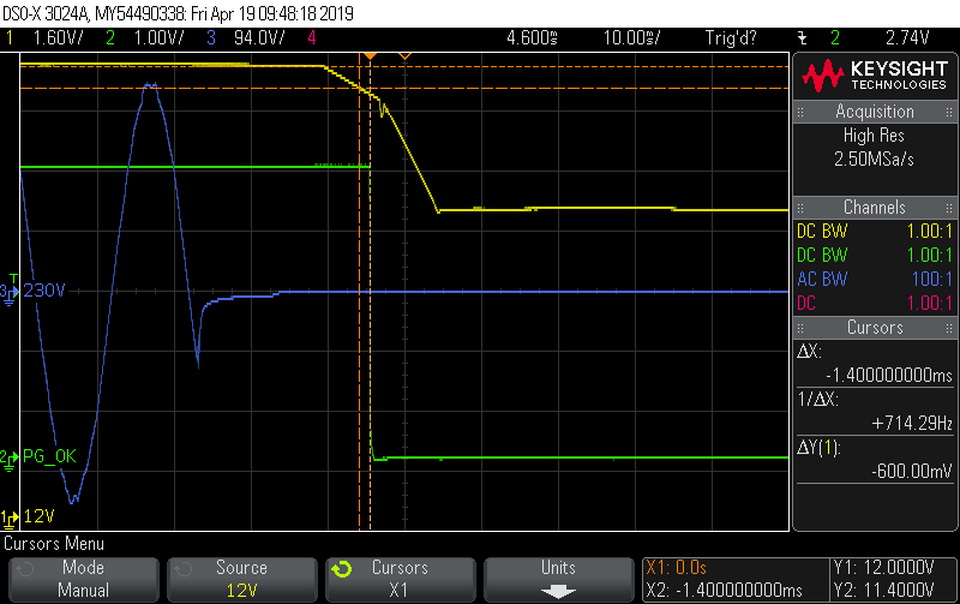
The hold-up time is longer than 20ms, but to our surprise the power ok signal is inaccurate. This is unacceptable of course.
Inrush Current
Inrush current, or switch-on surge, refers to the maximum, instantaneous input current drawn by an electrical device when it is first turned on. A large enough inrush current can cause circuit breakers and fuses to trip. It can also damage switches, relays, and bridge rectifiers. As a result, the lower the inrush current of a PSU right as it is turned on, the better.
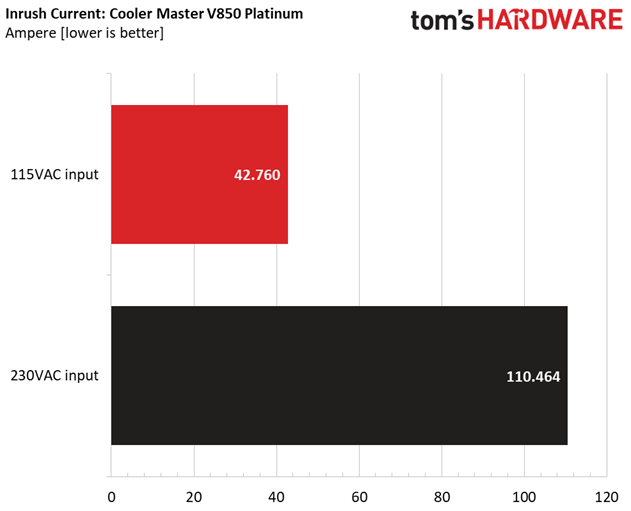
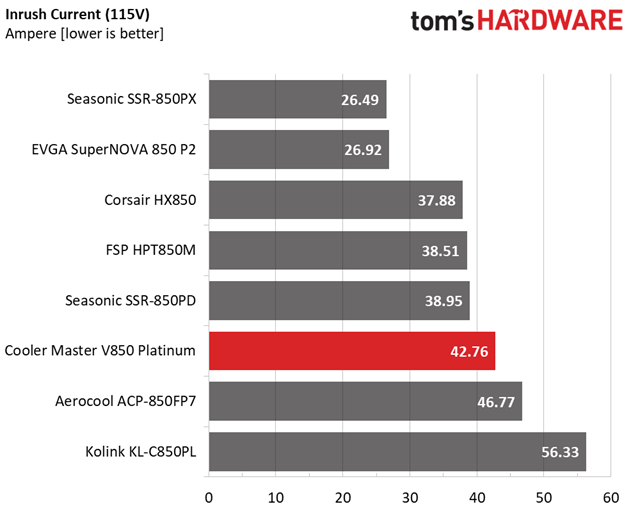
The inrush current is at normal levels with 115V and pretty high with 230V.
Get Tom's Hardware's best news and in-depth reviews, straight to your inbox.
10-110% Load Tests
These tests reveal the V850’s load regulation and efficiency levels under high ambient temperatures. They also show how the fan speed profile behaves under increased operating temperatures.
| Test # | 12V | 5V | 3.3V | 5VSB | DC/AC (Watts) | Efficiency | Fan Speed (RPM) | PSU Noise (dB[A]) | Temps (In/Out) | PF/AC Volts |
|---|---|---|---|---|---|---|---|---|---|---|
| 1 | 5.168A | 1.989A | 1.980A | 0.984A | 84.905 | 85.178% | 629 | 14.1 | 39.26°C | 0.942 |
| 12.251V | 5.025V | 3.331V | 5.084V | 99.680 | 43.40°C | 115.12V | ||||
| 2 | 11.315A | 2.987A | 2.974A | 1.184A | 169.410 | 89.610% | 621 | 13.8 | 40.21°C | 0.960 |
| 12.241V | 5.022V | 3.329V | 5.069V | 189.052 | 44.67°C | 115.12V | ||||
| 3 | 17.864A | 3.487A | 3.458A | 1.385A | 254.504 | 91.093% | 629 | 14.1 | 41.31°C | 0.966 |
| 12.231V | 5.020V | 3.327V | 5.054V | 279.389 | 46.12°C | 115.13V | ||||
| 4 | 24.423A | 3.987A | 3.969A | 1.588A | 339.704 | 91.573% | 629 | 14.1 | 41.90°C | 0.973 |
| 12.222V | 5.018V | 3.325V | 5.039V | 370.965 | 47.34°C | 115.13V | ||||
| 5 | 30.669A | 4.987A | 4.966A | 1.792A | 425.016 | 91.596% | 629 | 14.1 | 42.45°C | 0.978 |
| 12.211V | 5.016V | 3.322V | 5.025V | 464.010 | 48.81°C | 115.12V | ||||
| 6 | 36.859A | 5.985A | 5.963A | 1.996A | 509.509 | 91.329% | 767 | 19.8 | 42.92°C | 0.982 |
| 12.201V | 5.012V | 3.319V | 5.012V | 557.886 | 49.95°C | 115.12V | ||||
| 7 | 43.091A | 6.989A | 6.965A | 2.202A | 594.822 | 90.452% | 1206 | 32.5 | 43.41°C | 0.986 |
| 12.200V | 5.009V | 3.317V | 4.996V | 657.612 | 51.34°C | 115.12V | ||||
| 8 | 49.368A | 7.992A | 7.965A | 2.410A | 680.151 | 90.093% | 1397 | 35.8 | 43.73°C | 0.988 |
| 12.189V | 5.006V | 3.314V | 4.980V | 754.944 | 52.48°C | 115.11V | ||||
| 9 | 56.040A | 8.495A | 8.454A | 2.413A | 765.069 | 89.726% | 1662 | 40.3 | 44.63°C | 0.989 |
| 12.180V | 5.003V | 3.312V | 4.974V | 852.669 | 54.29°C | 115.11V | ||||
| 10 | 62.463A | 9.000A | 8.972A | 3.037A | 849.887 | 89.119% | 2181 | 47.0 | 45.95°C | 0.991 |
| 12.170V | 5.001V | 3.310V | 4.941V | 953.650 | 55.96°C | 115.11V | ||||
| 11 | 69.487A | 9.002A | 8.978A | 3.041A | 934.675 | 88.617% | 2188 | 47.2 | 46.74°C | 0.991 |
| 12.160V | 5.000V | 3.308V | 4.934V | 1054.737 | 57.42°C | 115.11V | ||||
| CL1 | 0.144A | 16.003A | 15.997A | 0.000A | 134.984 | 82.963% | 629 | 14.1 | 42.55°C | 0.959 |
| 12.235V | 5.004V | 3.322V | 5.109V | 162.704 | 48.79°C | 115.12V | ||||
| CL2 | 70.338A | 1.000A | 1.000A | 1.000A | 869.730 | 89.536% | 2182 | 47.1 | 45.28°C | 0.991 |
| 12.175V | 5.015V | 3.316V | 5.034V | 971.376 | 55.55°C | 115.10V |
Under high temperatures and with 20% and 50% load, the PSU doesn't reach the efficiency numbers that the 80 PLUS Platinum standard requires. Under full load, it manages to go over 89%, though.
Besides the loud fan noise, we didn't encounter any problem stressing the unit with full and even more power, under high operating temperatures. The V850 power supply is resilient to harsh conditions.
20-80W Load Tests
In the following tests, we measure the V850's efficiency at loads significantly lower than 10% of its maximum capacity (the lowest load the 80 PLUS standard measures). This is important for representing when a PC is idle, with power-saving features turned on.
| Test # | 12V | 5V | 3.3V | 5VSB | DC/AC (Watts) | Efficiency | Fan Speed (RPM) | PSU Noise (dB[A]) | PF/AC Volts |
|---|---|---|---|---|---|---|---|---|---|
| 1 | 1.178A | 0.497A | 0.480A | 0.195A | 19.533 | 65.341% | 630 | 14.2 | 0.826 |
| 12.259V | 5.019V | 3.330V | 5.124V | 29.894 | 115.12V | ||||
| 2 | 2.421A | 0.994A | 0.991A | 0.391A | 39.968 | 77.202% | 629 | 14.1 | 0.895 |
| 12.256V | 5.025V | 3.332V | 5.114V | 51.771 | 115.12V | ||||
| 3 | 3.594A | 1.492A | 1.468A | 0.588A | 59.431 | 81.818% | 629 | 14.1 | 0.931 |
| 12.253V | 5.027V | 3.332V | 5.104V | 72.638 | 115.12V | ||||
| 4 | 4.839A | 1.990A | 1.979A | 0.785A | 79.873 | 84.833% | 629 | 14.1 | 0.940 |
| 12.251V | 5.025V | 3.331V | 5.093V | 94.153 | 115.12V |
We would like to see higher than 70% efficiency with 20W load, and above 80% with 40W.
Efficiency
Next, we plotted a chart showing the V850’s efficiency at low loads, and loads from 10 to 110% of its maximum-rated capacity. The higher a PSU’s efficiency the less energy goes wasted leading to a reduced carbon footprint, besides lower electricity bills.
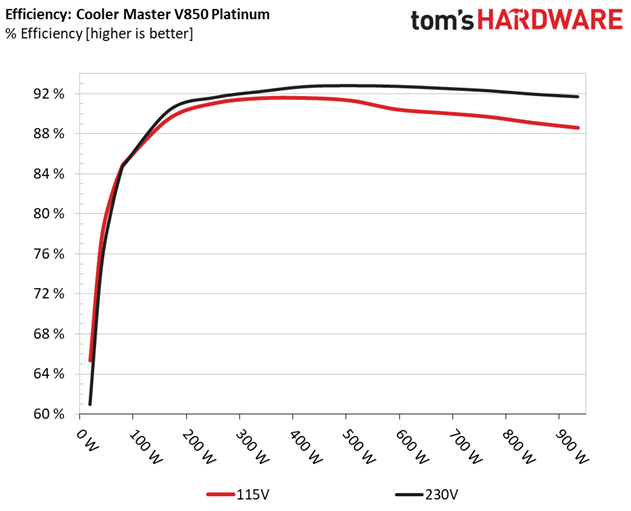
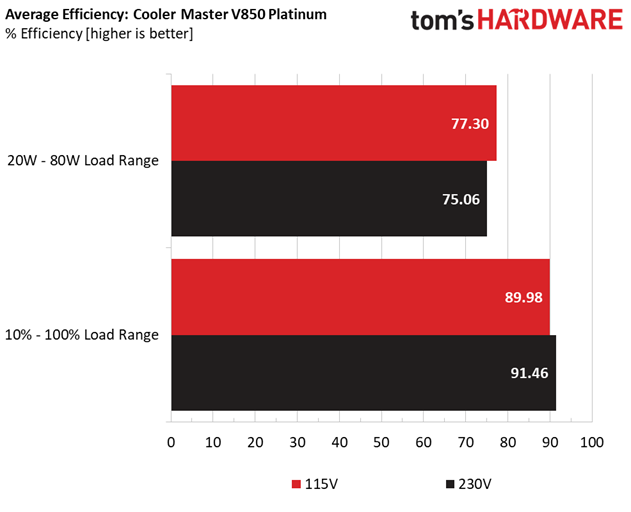
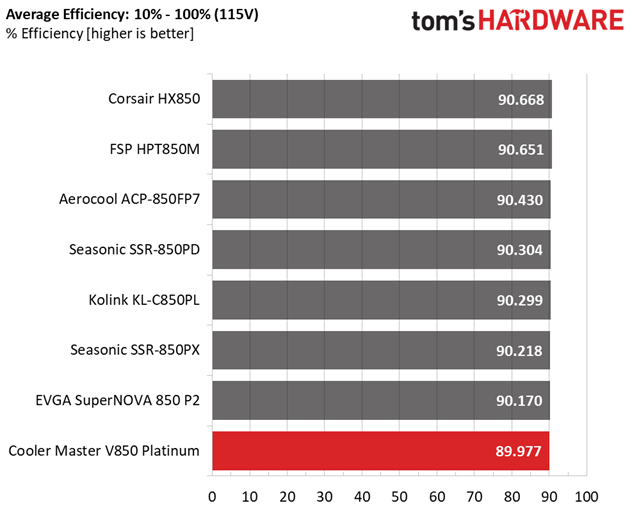
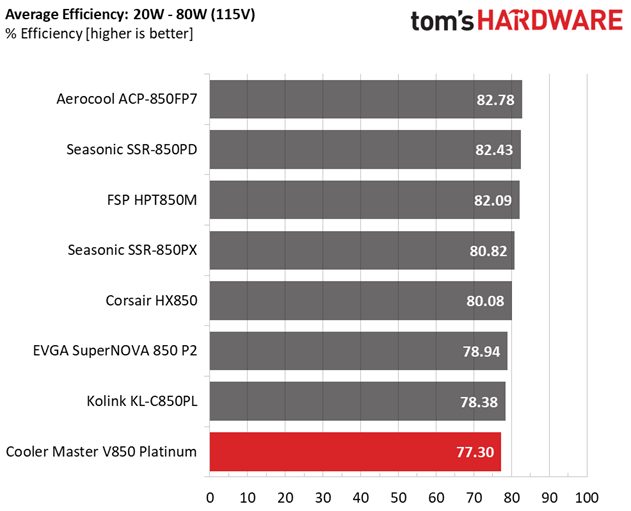
The Cooler Master V850 Platinum achieves low efficiency numbers in both our normal and light load tests. Especially in the latter, the differences are notable with the units that we used for comparison purposes.
5VSB Efficiency
| Test # | 5VSB | DC/AC (Watts) | Efficiency | PF/AC Volts |
|---|---|---|---|---|
| 1 | 0.100A | 0.513 | 79.782% | 0.042 |
| 5.131V | 0.643 | 115.10V | ||
| 2 | 0.250A | 1.281 | 82.326% | 0.097 |
| 5.125V | 1.556 | 115.10V | ||
| 3 | 0.550A | 2.812 | 83.048% | 0.193 |
| 5.112V | 3.386 | 115.10V | ||
| 4 | 1.000A | 5.093 | 83.192% | 0.295 |
| 5.092V | 6.122 | 115.10V | ||
| 5 | 1.500A | 7.607 | 82.309% | 0.368 |
| 5.071V | 9.242 | 115.11V | ||
| 6 | 3.000A | 15.034 | 78.985% | 0.470 |
| 5.012V | 19.034 | 115.11V |
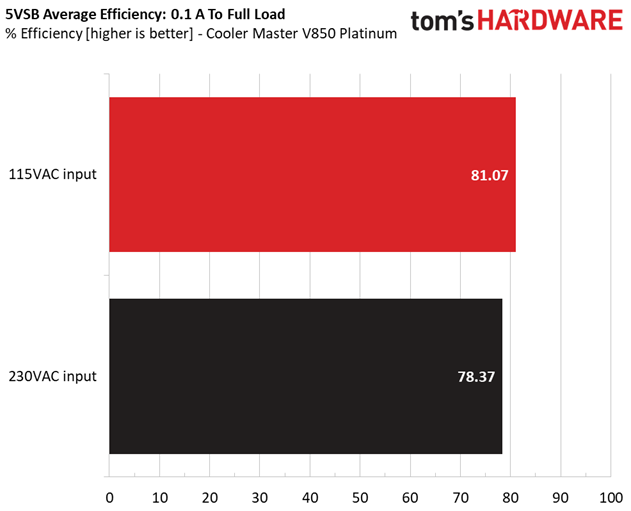

As it was the case with the V1300, the 5VSB rail is highly efficient. Clearly the 5VSB circuit is identical in those two models.
Power Consumption In Idle And Standby
| Mode | 12V | 5V | 3.3V | 5VSB | Watts | PF/AC Volts |
|---|---|---|---|---|---|---|
| Idle | 12.261V | 5.023V | 3.334V | 5.135V | 9.594 | 0.513 |
| 115.1V | ||||||
| Standby | 0.039 | 0.003 | ||||
| 115.1V |


Fan RPM, Delta Temperature, And Output Noise
All results are obtained between an ambient temperature of 37 to 47 degrees Celsius (98.6 to 116.6 degrees Fahrenheit).
The fan speed profile could be a bit smoother, under high operating temperatures. With 510W load the 767 RPM while with 85W more it increases its speed to 1206 RPM, outputting 12.7 dB(A) more.
The following results were obtained at 30 to 32 degrees Celsius (86 to 89.6 degrees Fahrenheit) ambient temperature.
With normal ambient temperatures and up to 500W loads, the power supply's noise stays below 20 dB(A), which is equivalent to the noise of a broadcast/recording studio. With more than 650W it enters the 30-35 dB(A) region (quiet suburban, night time).
MORE: Best Power Supplies
MORE: How We Test Power Supplies
MORE: All Power Supply Content
Current page: Load Regulation, Hold-Up Time, Inrush Current, Efficiency and Noise
Prev Page Specifications and Part Analysis Next Page Protection Features, DC Power Sequencing, Cross-Load Tests and Infrared Images
Aris Mpitziopoulos is a contributing editor at Tom's Hardware, covering PSUs.
